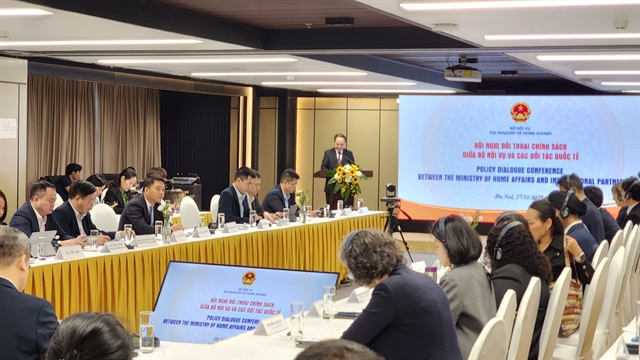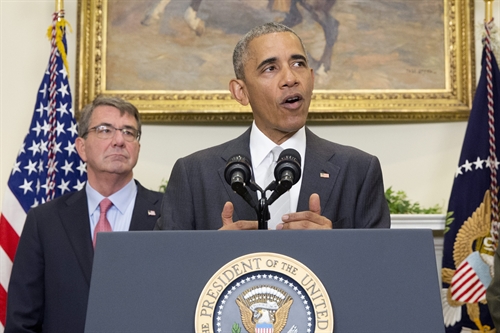 World
World

President Barack Obama on Wednesday put the brakes on the US pullout from Afghanistan, saying 8,400 troops will remain in the war-ravaged country into next year to tackle the threat from a resurgent Taliban.
 |
| US President Barack Obama (R) makes a statement on Afghanistan, beside US Secretary of Defense Ashton Carter (L), in the Roosevelt Room of the White House in Washington, DC, USA, 06 July 2016. — EPA/VNA Photo |
WASHINGTON — President Barack Obama on Wednesday put the brakes on the US pullout from Afghanistan, saying 8,400 troops will remain in the war-ravaged country into next year to tackle the threat from a resurgent Taliban.
Obama, who was elected in 2008 on a promise to end America’s longest war, had previously vowed to slash the US troop presence from its current level of 9,800 to 5,500 by 2017.
But he said a still "precarious" security situation, with Afghan security forces struggling to contain the Taliban, made such a move untenable.
"Instead of going down to 5,500 troops by the end of this year, the United States will maintain approximately 8,400 troops in Afghanistan into next year through the end of my administration," Obama said.
"It is in our national security interest, especially after all the blood and treasure we’ve invested in Afghanistan over the years, that we give our Afghan partners the very best opportunity to succeed," he added.
With only a few months left in office, Obama said additional troops would enable his successor to have "a solid foundation for continued progress" in Afghanistan.
Taliban spokesman Zabiullah Mujahid mocked his announcement.
"The more American invaders in Afghanistan, the more casualties they will suffer," he said on Twitter.
"They will certainly be defeated," he added. "We have good experience in fighting the idiots. We have high morale."
NATO mission
Most of the US troops, operating under the NATO banner, work as trainers or advisers to Afghan forces. Around 40 NATO members and partner countries currently contribute to the overall force of nearly 13,000.
It was not immediately clear whether Obama’s decision would influence other countries’ troop levels, expected to be a central issue at this week’s NATO summit in Poland.
"I welcome @BarackObama’s announcement on troop levels in Afghanistan. A strong signal of our continued commitment," NATO Secretary General Jens Stoltenberg said on Twitter.
Obama’s announcement effectively acknowledges that Afghan forces, which took charge of the country’s security in 2015, still face massive institutional shortcomings.
They have suffered devastating setbacks at the hands of the Taliban, including the temporary loss of the northern city of Kunduz, and more than 5,000 Afghan troops killed last year alone.
Other organizations, including the Islamic State group, have meanwhile stepped up activity.
"The security situation in Afghanistan remains precarious," said Obama, who last month unveiled looser rules making it easier for US forces to strike Taliban targets.
"Afghan security forces are still not as strong as they need to be," he added. "With our help, they’re still working to improve critical capabilities, such as intelligence, logistics, aviation and command and control."
Optics and politics
Stephen Biddle, an Afghanistan expert and professor at George Washington University, said adjustments to the comparatively small US troop presence – the Afghans have about 320,000 police and troops – would make little difference to local security capabilities until Afghanistan tackles issues such as deeply entrenched corruption.
"The ability of the Afghans to hold the line is not primarily being shaped by whether there are 9,800 or 8,400 or 5,500 US soldiers," Biddle said, noting that the troop count is "more about the optics and the politics of this than it is about military capability."
In particular, the Pentagon needs to maintain a steady troop level to ensure continued Congressional funding for the Afghan cause, Biddle said.
Obama himself acknowledged the solution to the conflict, which has dragged on for 15 years, would not be military alone.
"The only way to end this conflict and to achieve a full drawdown of foreign forces from Afghanistan is through a lasting political settlement between the Afghan government and the Taliban," he said.
"That is why the United States will continue to strongly support an Afghan-led reconciliation process, and why we call on all countries in the region to end safe havens for militants and terrorists."
But diplomatic efforts to engage with the Taliban are in disarray. The United States in May killed the group’s leader, Mullah Akhtar Mansour, in a drone strike in Pakistan.
Obama’s decision follows a review of the security situation by General John Nicholson, the new commander of the US-led NATO mission in Afghanistan.
Republican Senator John McCain, a longtime critic of Obama’s military policies, welcomed the move, but said the president should have kept the entire 9,800 US troops in the country.
Still, he said, "the decision to retain 8,400 US troops in Afghanistan into next year is certainly preferable to cutting those forces by nearly half."
US forces have been in Afghanistan since the US-led invasion to oust the Taliban in late 2001.
The United States has spent around US$1 trillion in total since, and some 2,200 American lives have been lost in the longest war in US history. — AFP




